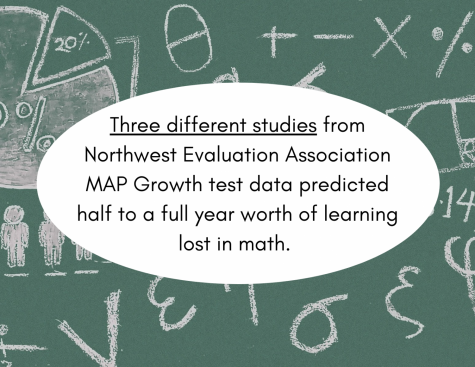Your donation will support the student journalists in the AVJournalism program. Your contribution will allow us to purchase equipment and cover our annual website hosting costs.
Gloom in Zoom
Nation-wide, teachers and students agreed that math over Zoom was, to say the least, tough, no matter which course they taught or studied. The learning loss effects, though not irrevocable, could be devastating, according to three different studies from Northwest Evaluation Association data that predicted half to a full year worth of learning lost in math.

“Zoom teaching isn’t exactly great for maths, so we’re all like a year-and-a-half behind from our first half year of math [in 2019], and then the whole year on Zoom just kind of messed all of us up a little bit,” said Algebra II student Alena Gagnon (‘23).
Part of this was how teachers couldn’t directly see their students’ calculations and thought process in working out an answer, which impaired their ability to assess what students were doing right or wrong.
“Students didn’t necessarily have access to show me their work easily, so a lot of times they would have the wrong answer and they’d try to explain to me what they did, but I couldn’t see what was happening,” said Honors Pre-calculus and AP Statistics teacher Colette Woodruff-Tropp.
Algebra I and II teacher Kyle Riddle used to regularly walk around his classroom to check on student progress, whereafter he could make minor tweaks to his lesson plans to help students understand concepts better. But on Zoom, he couldn’t catch small mistakes as often.
“I wasn’t able to make those small tweaks, and those small [mistakes] turned into bigger problems and then it kind of spiralled out of control for certain aspects,” said Riddle. “Then when quizzes and tests came around, I could see [the mistakes], but it was a little bit too late to fix them and make them small tweaks.”
For Algebra I and honors algebra II teacher Samantha Allen, online classes forced a change in her teaching style from an interactive and student-based design to a heavily limited teacher-centered format.
“A lot of what I do, for example walking around and going to the different [table] groups, wasn’t feasible on Zoom, so it was very lecture-based, like it was pretty much me talking the whole period,” said Allen.
Over Zoom, where the majority of students avoided showing their faces on camera and muted their microphones, those who needed help had less confidence and motivation to reach out to their teachers.
“Doing math in-person is better, because when the teacher’s working through a problem and you don’t understand something in the middle, like ‘how did we get that number out of nowhere?’ you can straight-up ask them and it’s just easier to communicate that way,” said Mark Attia (‘23), a junior in Algebra II.